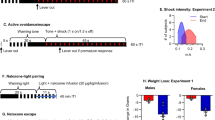Abstract.
Rationale: Traumatic life events can induce long-term alterations in neuronal substrates, which may ultimately lead to the development of anxiety disorders. It has been postulated that corticotropin-releasing hormone (CRH) plays an important role in anxiety-like behavior. Objectives: (1) To study the long-term effects of a single foot-shock experience on defensive withdrawal (DW) behavior in rats. (2) To examine the effects of the benzodiazepine anxiolytic drug chlordiazepoxide on the behavior of preshocked and control rats in the DW test. (3) To study the role of endogenous CRH in the long-term stress-induced increase in DW behavior. Methods: (1) Rats were exposed to a single session of foot shocks or exposed to the grid cage without receiving any shocks. Two, six and ten weeks later, rats were tested in the DW tests (2, 3). In subsequent experiments, rats were exposed to foot shocks or exposed to the grid cage without receiving any shocks, and 2 weeks later the effect of pharmacological treatments on the behavioral response in the DW test was investigated. Chlordiazepoxide (1, 5, 10 mg/kg BW, i.p.) and the CRH antagonists D-Phe CRH(12–41) (0.2, 1, 5 µg per rat, i.c.v.) and α-helical CRH(9–41) (5 µg per rat, i.c.v.) were injected 30 min before the test. Results: A single session of foot shocks induced a long-term increase in DW behavior, which persisted after repeated testing for at least 10 weeks. Chlordiazepoxide decreased the latency but did not affect time spent in light, distance moved, or the number of entries in the open field. D-Phe CRH(12–41) had no behavioral effects. α-Helical CRH(9–41) increased the time spent outside the box, primarily as a result of effects of α-helical CRH(9–41) in controls. Conclusion: These data demonstrate that preshocked rats display long-term increased anxiety-like behavior in the DW test but that CRH is unlikely to be involved in its expression.
Similar content being viewed by others
Author information
Authors and Affiliations
Additional information
Electronic Publication
Rights and permissions
About this article
Cite this article
Bruijnzeel, .A., Stam, .R. & Wiegant, .V. Effect of a benzodiazepine receptor agonist and corticotropin-releasing hormone receptor antagonists on long-term foot-shock-induced increase in defensive withdrawal behavior. Psychopharmacology 158, 132–139 (2001). https://doi.org/10.1007/s002130100863
Received:
Accepted:
Issue Date:
DOI: https://doi.org/10.1007/s002130100863




